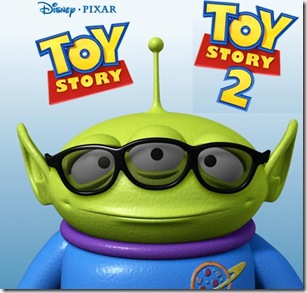The Toy Story films were among the earliest full-length features to be produced in CGI. While they were amazing to look at – seeming more like 3-D than traditional hand drawn and painted animation, they would have been a curiosity if not for two things: they featured engaging characters in simple but brilliant stories.
Now Toy Story and toy Story 2 are being re-released in 3-D for two weeks. Given that the films were originally produced through three-dimensional imaging in the PIXAR computers, it should come as no surprise that they were easily adapted to Disney’s Digital 3-D process. The result is good enough that I think I can safely say that, in this instance, at least, Roger Ebert is wrong. 3-D is not a fad.
In the case of Toy Story and Toy Story 2, 3-D gives the films a feeling of greater density. Figures seem to be moving in a real – if somewhat different – world. Gags that were funny the first time become brand new again [“I don’t want to use my head!”] and even if they’re toys, their facial expressions are even more effective in 3-D.
It doesn’t hurt that the Toy Story films are classics – they’d both have gotten A+ grades from me if I’d been reviewing them when they were originally released [fourteen years ago for Toy Story; ten for Toy Story 2].Even in 2-D, these are brilliant films and they will last even without 3-D – but when Disney [or somebody] perfects this 3-D process for DVD/Blu-ray, they’ll probably top the sales charts again.
In the meantime, you can judge for yourself how well the 3-D works sometime in the next two weeks.
Note that there is 10-minute intermission between movies – which is not nearly enough time for a theater full of kids to hit the head and replenish their snacks. For those who choose to sit through the intermission, there’s a ten-minute collection of Toy Story Trivia & Treats [the treats are brief original scenes featuring the characters from both movies – and they are great stuff!].
Final Grade: A+
